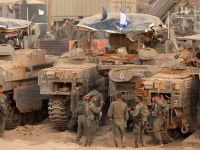A failed attempt by supporters of former president Joseph Estrada to seize the presidential palace Tuesday triggered the worst rioting in the Philippine capital since the overthrow of the dictator Ferdinand Marcos 15 years ago.
President Gloria Arroyo cracked down on protesters and their alleged backers, including at least two senators and two generals, using special powers to declare a state of rebellion allowing for arrests without warrants.
A simmering crisis which began with Estrada's arrest last week on corruption charges boiled over with a pre-dawn march on the palace by some 8,000 people led by angry young men armed with an improvised arsenal of homemade shotguns, rocks, firebombs and sticks.
They breached several layers of police cordons all the way to the palace gates in a bid to force Arroyo to step down, but were finally repulsed by security forces with the aid of troops firing volleys from M16 rifles into the air.
After being pushed back, the ragtag army from the urban poor, the power base of former movie star Estrada, vented their indignation with an orgy of looting and vandalism around the palace.
One policeman and two civilians were dead before the morning was over. At least 138 people were injured and more than 100 demonstrators arrested. Arroyo earlier said two policemen were killed but aides said an officer thought to have been lynched survived a mauling.
It was the first time a mob managed to reach the heavy wrought-iron gates of the Spanish colonial-era Malacanang palace complex since Marcos was ousted by a "people power" uprising in February 1986.
Soon after the Marcoses were evacuated by US military helicopters en route to exile in Hawaii, protesters broke through the gates and looted the palace of everything from assault weapons to fancy underwear from former first lady Imelda Marcos's boudoir.
Tuesday's violence prompted the government to discard its "maximum tolerance" policy.
Officials said the government had uncovered a plot to install a junta using the civilian protesters as "human bait."
The list of personalities ordered rounded up included Senator Juan Ponce Enrile, a former defense minister, and Senator Gregorio Honasan, a former army colonel, who were both linked to right-wing military coup plots in the late 1980s.
Enrile was arrested at his mansion and taken to the national police headquarters.
Estrada and his co-accused politician son Jose Ejercito, who will both be put on trial on June 27, were flown by helicopter to a special detention center outside Manila as the riots were raging in the city.
They have been charged with economic plunder, which is punishable by death, for allegedly amassing 80 million dollars in illicit wealth through kickbacks and embezzlement.
In a statement from prison, Estrada said the blood of the victims was "now in the hands of those in power" and warned that "the struggle has just begun."
His supporters demanded that Arroyo step down and return the presidency to him.
"I don't think that it was possible to talk reason into them. The only logical response was to call in the police and the military," said Carolina Hernandez, head of a local think tank, the Institute for Strategic and Development Studies.
"With a few exceptions, the dispersal operations were conducted with excessive tolerance," said the political scientist, adding that the marchers "were really spoiling for a fight."
As they were progressively driven away from the palace, rioters set fire to a police car and motorcycle, three pickups owned by a television station, an ambulance, construction equipment and a traffic police outpost. Other vehicles were stoned and looted. Black smoke billowed from the littered streets around the palace.
"We did not expect this. This is irrational," national security adviser Roilo Golez said after surveying the aftermath.
Senior opposition politicians and the Estrada family swiftly disowned the attack on the palace but the government vowed to go to the root of the alleged plot to restore the Estrada administration -- MANILA (AFP)
© 2001 Al Bawaba (www.albawaba.com)







